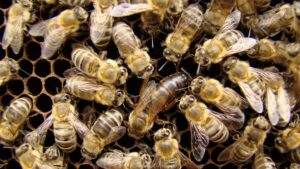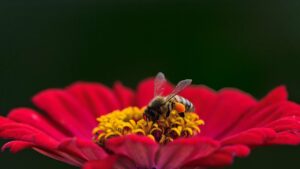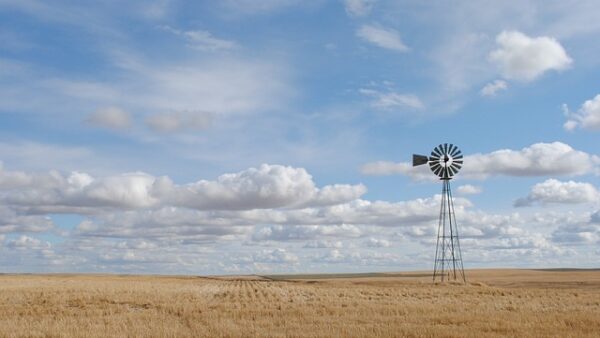Weather Worries Beekeepers
Bees are adaptive and can survive in diverse geographic locations with very different climatic conditions, ranging from seven months of near Arctic temperatures in Newfoundland, Canada, to the fiery hot conditions of Arizona.
While adaptive, honeybees can be affected by changing weather, and beekeepers must stay on their toes and manage accordingly, says Dick Rogers, Bayer CropScience bee health research manager. Located at Bayer’s Bee Care Center in North Carolina’s Research Triangle Park, Rogers has been keeping bees for more than 40 years.
“As a beekeeper, you must constantly be aware of the environment and what food and forage are available,” Rogers says.
The weather can be severe: ice storms, snow storms, hurricanes, tornadoes, floods and sudden temperature changes. These are just a few events that can lead to bee troubles. When a large area is affected by a weather event, it can take a toll on bees, says Richard Fell, a Virginia Tech professor emeritus, entomologist and longtime beekeeper.
Honeybee colonies are complex structures and change with the turning of the seasons. Fell explains that colonies are well tuned to the annual weather cycle.
The weeks when the weather begins to shift from winter to spring are critical because this is when bees are trying to expand their brood. Beginning in the spring, colonies are swarming and reproducing rapidly, which means they’re dependent on nectar to grow and expand. Rogers says that for the eggs to hatch, the relative humidity in each brood cell needs to be high, often much higher than the humidity outside the hive.
Once the bees have started this growth cycle, a change or sudden drop in temperature can affect the hive. Fell reports that a few years ago, the change toward spring weather was about two to three weeks early in North Carolina, and then temperatures dropped back down and it even snowed.
In instances such as this, Fell recommends beekeepers provide an emergency feeding to help the bees nutritionally survive the cold spurt. “Erratic weather can make it difficult for the beekeeper and bee to manage through,” Fell says.
The spring months often bring flooding to certain regions. “Floods can drown bees and create excess moisture in the hive, which promotes mold growth and can lead to chalkbrood disease,” Rogers says. “Beekeepers need to make sure the hive is positioned or arranged so that rain cannot flow into the hive entrance.”
Additionally, tornadoes and strong winds can cause trouble. Rogers reports that several beekeepers were affected by tornadoes this past year. Unfortunately, there’s not much that can be done to protect bees when a tornado hits. However, in the event of high winds, beekeepers can place hives in sheltered locations to prevent wind from infiltrating hives, blowing cover off of hives or knocking the hives over. Additionally, high winds can lead to excessive hive cooling and over-ventilation, Rogers says.
In late spring to early summer, there’s typically an abundance of nectar and pollen from blooming trees, shrubs and other plants. This is when the bees are producing honey, he explains.
DID YOU KNOW?
Depending on its size, a healthy bee colony in the north consumes 40 to 60 pounds of honey during the winter months.
Depending on geographic location, July and August often bring hot, dry weather, which leads to a reduction in blooming plants and a subsequent lack of natural forage for the bees. This is also a typical period for drought. In certain regions, prolonged periods of drought and high temperatures are more common and can result in food shortages for bees.
Rogers explains that drought can also lead to low relative humidity and reduce access to water. “This affects the brood by reducing successful egg hatch,” he says. “It also affects the bees’ natural cooling mechanism — evaporative cooling — which only works with access to water. A lack of water can lead to problems with basic bee functioning.”
Additionally, late summer droughts hinder the ability of a colony to raise winter bees. “This means you have older bees going into winter, which typically results in greater winter losses,” Fell says.
In conditions such as these, Rogers recommends beekeepers provide access to water. “In extreme heat, you can shade bees and add extra ventilation in the hive by creating extra openings, leaving the hive cover set back a bit or staggering the boxes which make up the hive,” he says.
As the weather turns cold in the late fall and into winter, bees form what is known as a winter cluster where they maintain a core temperature of about 90 degrees. The heat generated by the tight cluster of bees allows them to survive.
QUICK FACT
A healthy, strong colony of honeybees can have up to 30,000 bees going into winter and 60,000 to 80,000 bees in late spring.
In midwinter in the north, the colony starts producing brood, which will develop into adult honeybees. The temperature around the brood must be maintained at about 92-95 degrees for successful brood development. This marks the beginning of colony expansion for the year. During these winter months, it’s important to get a few days of warm weather so bees can go out and defecate and shift to other areas of the hive to access food reserves.
These winter months, especially in northern locations, leave bees susceptible to ice storms. “If you have an ice storm that totally covers the hive, the entire colony can suffocate,” Rogers says, noting that beekeepers must be quick to open ventilation holes in the hives.
Fell adds that winter bees physiologically differ from summer bees. Winter bees have fat storage and other mechanisms for coping with long periods of confinement in cold conditions.
“In the summer, bees live an average of five weeks, but the winter bees will live three to eight months,” Fell says. “As bees move into winter time, they remain physiologically young because they are not exposed to all the stressors of the environment. They’re not out flying around collecting nectar all day, foraging or
rearing young.”
Hive Management
Today, Fell says some beekeepers put their hives on a scale, which helps to clue them in as to what’s going on inside. In the spring and summer, an increase in weight indicates how productive the bees are when nectar is flowing, while a decrease indicates that nectar might be scarce and the bees are consuming more food than they are collecting.
Some beekeepers are moving toward smart hives, which are equipped with sensors that track the temperature, humidity and even the movement of the bees, all of which can be used to assess the health and behavior of the colony.
Beekeepers can’t control the weather, but they can control their management.
“Many of these events can be anticipated and many are inevitable throughout the years,” Rogers says. “It’s important for beekeepers to be prepared and have a plan for when these weather conditions and events occur.”
Bee Care: A Story of Goldilocks
Honeybees can survive a number of conditions, but just as Goldilocks in “Goldilocks and the Three Bears” prefers the porridge and the chair that is ‘just right,’ bees prefer an environment that is just right. Honeybees are sensitive to the following:
• Too much moisture in the hive.
• Too much or too little ventilation.
• Sudden and extreme changes in temperature.
• Prolonged cold and heat.
• False starts in the spring, which lead to a lack of food.
• Unusual changes in sequence and duration of bloom as a result of weather.
• Lack of water availability.















